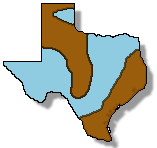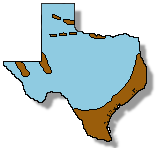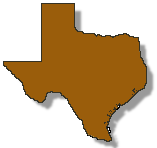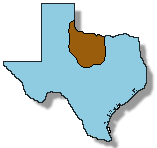

The Chihuahuan Desert Through Time
You may click on any of the underlined links to learn about the different kinds of fossils mentioned in the text. To return to where you left off, simply click on the BACK button on the top tool bar.
By understanding the geologic history of the Chihuahuan Desert, we can understand the significance of some of the area's most interesting features, including its plants and animals.
When viewing this site and reading through the geologic history, it is important to remember that the Earth's geologic history covers a time span of about 4.6 billion years! The oldest rocks presently exposed in our area date to about 980 MYA (million years ago), so that only a small portion of the Earth's entire history is visible within this area. However, geologists have constructed a timeline of geologic events that affected the Chihuahuan Desert during the Paleozoic, Mesozoic, and Cenozoic eras.
The rest of this page is a geologic timeline divided into significant periods in the development of the Chihuahuan Desert in West Texas. Ancient history is at the top of the page, more recent history at the bottom. The maps of Texas illustrate the level of the ocean during the time period to which they are adjacent. The blue represents ocean, and the brown represents land above the ocean.
|
Cambrian -- North America is
covered by a shallow ocean belt that extends southeast to northwest from the
Gulf of Mexico to the Pacific Northwest. Marine life included
trilobites, brachiopods, bryozoans, snails, clams, and sponges. The Cambrian Period marks the first time that multicellular organisms appear in abundance. |
 |
Ordovician, Silurian, Devonian, Mississippian -- Shallow seas continue to cover the region. Limestone and chert beds were deposited, some of which contain brachiopod, coral, cephalopod (squid family),
and gastropod (snail) fossils. The numbers and diversity of corals increase dramatically, and the first land plants appear.
The Devonian Period is when the first amphibians evolved. Marine life also showed great leaps in evolution, with the development of more complex and numerous species of fish. Occasionally the seas receded somewhat, and land plants thrived in a marshland environment -- the most common plants were ferns and horsetail rushes. Fern forests and amphibians thrived on land, and the seas (which still covered portions of West Texas) were filled with a multitude of organisms. |

|
Pennsylvanian -- During most of the Pennsylvanian, the region was covered by shallow seas. However,
towards the end of the Pennsylvanian Period (approximately 300 MYA), the cataclysmic
collision of North America with South America and Africa caused the entire West Texas
region to rise above sea level, exposing much of it to a land environment
for the very first time. To view what the continents looked like after this "big crunch"
CLICK HERE. |

|
|
|

|
|
Permian --This was
the age of the reptiles. Many different reptile groups evolved during this age. The first pre-dinosaur
reptiles emerged during the Permian.
|

|
Triassic, Jurassic -- There is no record of Triassic/Jurassic aged rocks in our area. When there appears to be a gap in the rock record, it is called an unconformity.
|

|
Cretaceous (early) -- During the early Cretaceous, West Texas was again covered by ocean. Ammonites and other shellfish are predominantly found amongst the sandstones and limestones deposited during this time period. Because the sediments show that the ocean was first fairly deep then less deep, we can infer that the ocean was receding
toward the end of the early Cretaceous.
|

|
Late Cretaceous -- The late Cretaceous was a time of uplift for the region. This caused the ocean to recede, and vast swamplands with dense vegetation took its
place. Considerable clay was deposited and, with it, dinosaur fossils. It was during this time that flowering plants first grew in the area. The end of the Cretaceous is marked by the extinction of all dinosaurs.
|
Cenozoic Era
|
66 MYA - Present
|
Paleocene -- The Paleocene epoch was the calm before the volcanic storm struck. The oceans receded to close to where they presently are. Land plants continued to evolve, and mammals began to fill the void left by the extinction of the dinosaurs.
|
|
Eocene -- The Franklin Mountains, Sierra de Juarez, and Mount Cristo Rey made their debut during this time period. As the Franklins rose, the basin east of the mountains sank. There was also a great amount of volcanic activity in this area during the Eocene.
|
|
Oligocene -- The Oligocene marks another violent period of time in the history of the region. During this time, yet another volcanic episode occurred.
|
|
Miocene -- Deposition of sediments into low-lying basins continued throughout the Miocene and Pliocene. By late Pliocene, a vast lake (Lake Cabeza de Vaca)
had formed, covering the lowlands of southern New Mexico, northern Chihuahua, and the El Paso region of Texas. As the basins filled, the ancestral Rio Grande was diverted through the pass between the Organ and Franklin mountains and flowed southward down the eastern side of the Franklins. ventually, in the late Pleistocene, the river was diverted again into the Mesilla Valley, to eventually break through the present pass on its way to the sea, and Lake Cabeza de Vaca disappeared.
|
|
Quaternary Period -- Loads of sand and silt are carried from areas of high elevation to lower elevations by rainfall. They are eventually swept to the Gulf of Mexico by way of the Rio Grande. Desert vegetation and sparse grasslands now cover the area. Bears, javelina, rabbits,
and coyotes inhabit the region. The Potrillo volcanic field, just west of El Paso, was very active during this timeframe and activity continued until about 40,000 years ago.
West Texas' geologic history is unique, a mixture of placid ocean deposition, murky swamps
with large reptiles, and violent earth-shaking volcanic eruptions. Now you know a bit about the geologic
history of the area. Next visit one of the links below to take you to an examination of how the geological past of West Texas influences our current biology. You may also choose the Earth Science Link to learn more about the great tectonic forces that are still active in the region.
|
LINKS
Choose this link to visit the
LIFE SCIENCE pages.
Choose this link to visit the
EARTH SCIENCEpages.
If you are on line with the Internet, choose this link to learn more about the
BIG BEND area.
Graphics from Cain Neal; The Big Bend Web Site. Used with permission.






